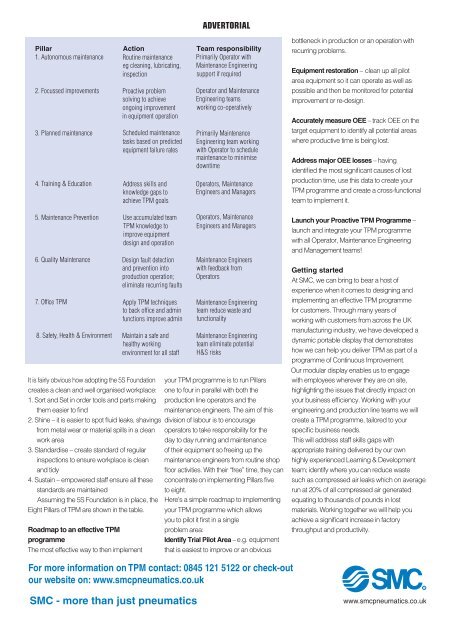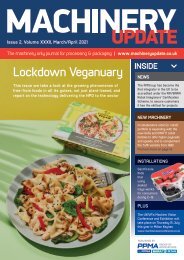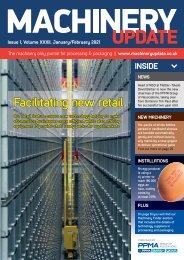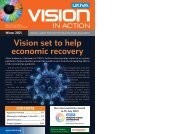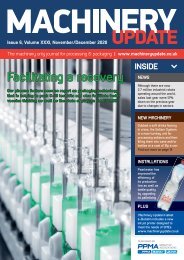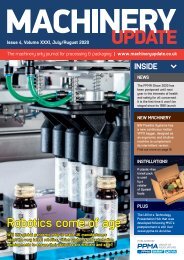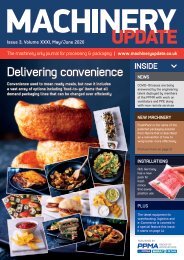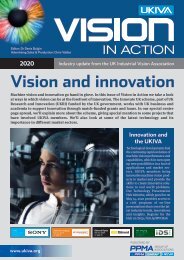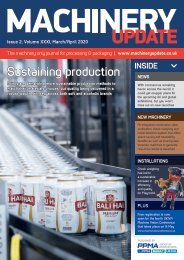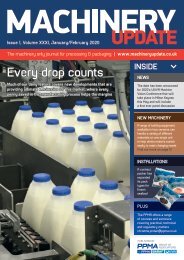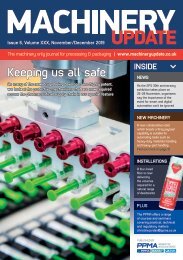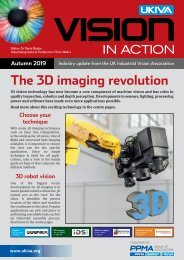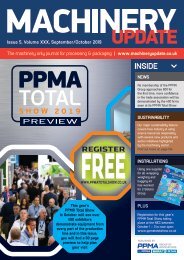MU 2017 November December
- No tags were found...
Create successful ePaper yourself
Turn your PDF publications into a flip-book with our unique Google optimized e-Paper software.
ADVERTORIAL<br />
Pillar<br />
1. Autonomous maintenance<br />
2. Focussed improvements<br />
3. Planned maintenance<br />
4. Training & Education<br />
Action<br />
Routine maintenance<br />
eg cleaning, lubricating,<br />
inspection<br />
Proactive problem<br />
solving to achieve<br />
ongoing improvement<br />
in equipment operation<br />
Scheduled maintenance<br />
tasks based on predicted<br />
equipment failure rates<br />
Address skills and<br />
knowledge gaps to<br />
achieve TPM goals<br />
Team responsibility<br />
Primarily Operator with<br />
Maintenance Engineering<br />
support if required<br />
Operator and Maintenance<br />
Engineering teams<br />
working co-operatively<br />
Primarily Maintenance<br />
Engineering team working<br />
with Operator to schedule<br />
maintenance to minimise<br />
downtime<br />
Operators, Maintenance<br />
Engineers and Managers<br />
bottleneck in production or an operation with<br />
recurring problems.<br />
Equipment restoration – clean up all pilot<br />
area equipment so it can operate as well as<br />
possible and then be monitored for potential<br />
improvement or re-design.<br />
Accurately measure OEE – track OEE on the<br />
target equipment to identify all potential areas<br />
where productive time is being lost.<br />
Address major OEE losses – having<br />
identified the most significant causes of lost<br />
production time, use this data to create your<br />
TPM programme and create a cross-functional<br />
team to implement it.<br />
5. Maintenance Prevention Use accumulated team<br />
TPM knowledge to<br />
improve equipment<br />
design and operation<br />
6. Quality Maintenance<br />
7. Office TPM<br />
8. Safety, Health & Environment<br />
It is fairly obvious how adopting the 5S Foundation<br />
creates a clean and well organised workplace:<br />
1. Sort and Set in order tools and parts making<br />
them easier to find<br />
2. Shine – it is easier to spot fluid leaks, shavings<br />
from metal wear or material spills in a clean<br />
work area<br />
3. Standardise – create standard of regular<br />
inspections to ensure workplace is clean<br />
and tidy<br />
4. Sustain – empowered staff ensure all these<br />
standards are maintained<br />
Assuming the 5S Foundation is in place, the<br />
Eight Pillars of TPM are shown in the table.<br />
Roadmap to an effective TPM<br />
programme<br />
The most effective way to then implement<br />
Design fault detection<br />
and prevention into<br />
production operation;<br />
eliminate recurring faults<br />
Apply TPM techniques<br />
to back office and admin<br />
functions improve admin<br />
Maintain a safe and<br />
healthy working<br />
environment for all staff<br />
Operators, Maintenance<br />
Engineers and Managers<br />
Maintenance Engineers<br />
with feedback from<br />
Operators<br />
Maintenance Engineering<br />
team reduce waste and<br />
functionality<br />
Maintenance Engineering<br />
team eliminate potential<br />
H&S risks<br />
your TPM programme is to run Pillars<br />
one to four in parallel with both the<br />
production line operators and the<br />
maintenance engineers. The aim of this<br />
division of labour is to encourage<br />
operators to take responsibility for the<br />
day to day running and maintenance<br />
of their equipment so freeing up the<br />
maintenance engineers from routine shop<br />
floor activities. With their “free” time, they can<br />
concentrate on implementing Pillars five<br />
to eight.<br />
Here’s a simple roadmap to implementing<br />
your TPM programme which allows<br />
you to pilot it first in a single<br />
problem area:<br />
Identify Trial Pilot Area –e.g. equipment<br />
that is easiest to improve or an obvious<br />
Launch your Proactive TPM Programme –<br />
launch and integrate your TPM programme<br />
with all Operator, Maintenance Engineering<br />
and Management teams!<br />
Getting started<br />
At SMC, we can bring to bear a host of<br />
experience when it comes to designing and<br />
implementing an effective TPM programme<br />
for customers. Through many years of<br />
working with customers from across the UK<br />
manufacturing industry, we have developed a<br />
dynamic portable display that demonstrates<br />
how we can help you deliver TPM as part of a<br />
programme of Continuous Improvement.<br />
Our modular display enables us to engage<br />
with employees wherever they are on site,<br />
highlighting the issues that directly impact on<br />
your business efficiency. Working with your<br />
engineering and production line teams we will<br />
create a TPM programme, tailored to your<br />
specific business needs.<br />
This will address staff skills gaps with<br />
appropriate training delivered by our own<br />
highly experienced Learning & Development<br />
team; identify where you can reduce waste<br />
such as compressed air leaks which on average<br />
run at 20% of all compressed air generated<br />
equating to thousands of pounds in lost<br />
materials. Working together we will help you<br />
achieve a significant increase in factory<br />
throughput and productivity.<br />
For more information on TPM contact: 0845 121 5122 or check-out<br />
our website on: www.smcpneumatics.co.uk<br />
SMC - more than just pneumatics<br />
www.smcpneumatics.co.uk


